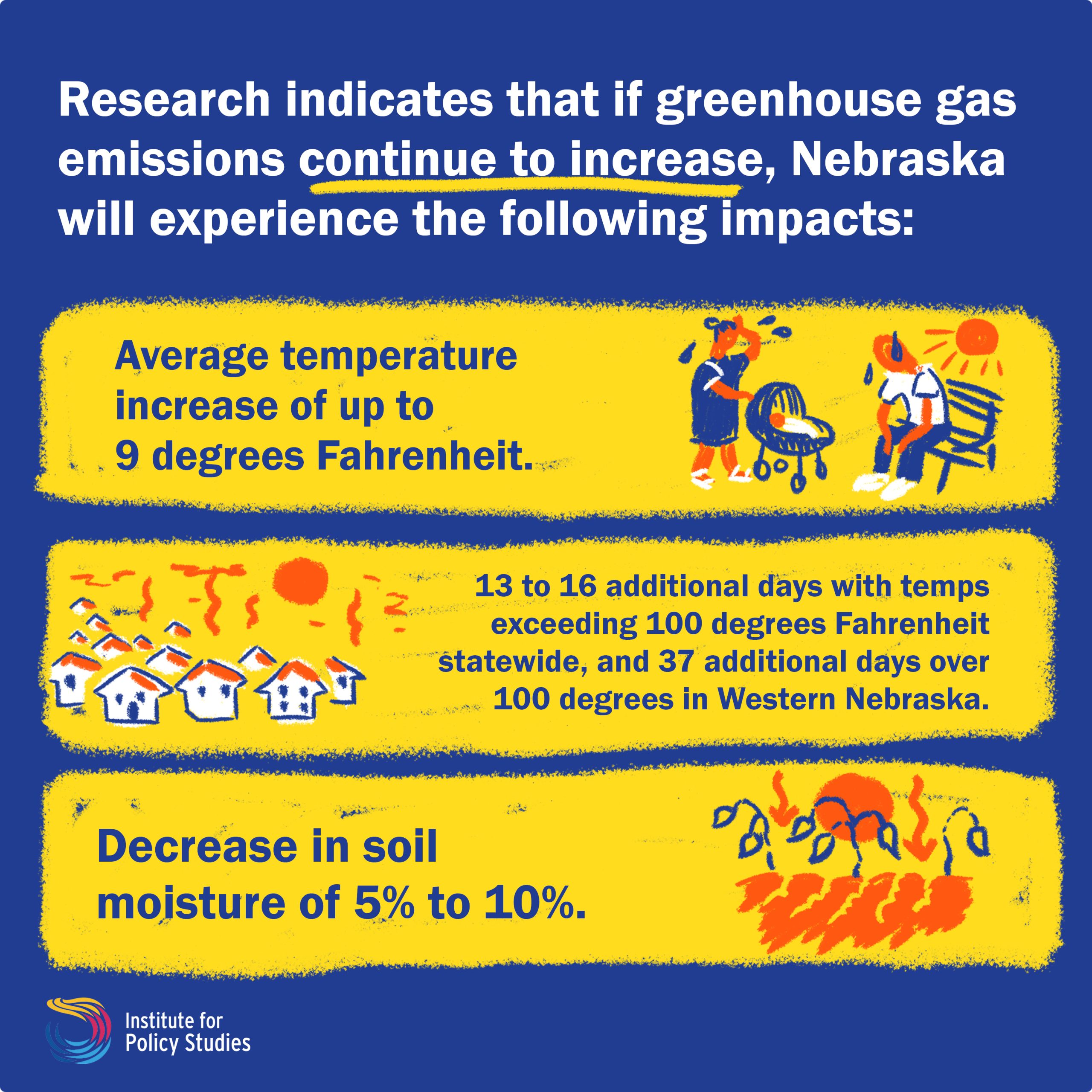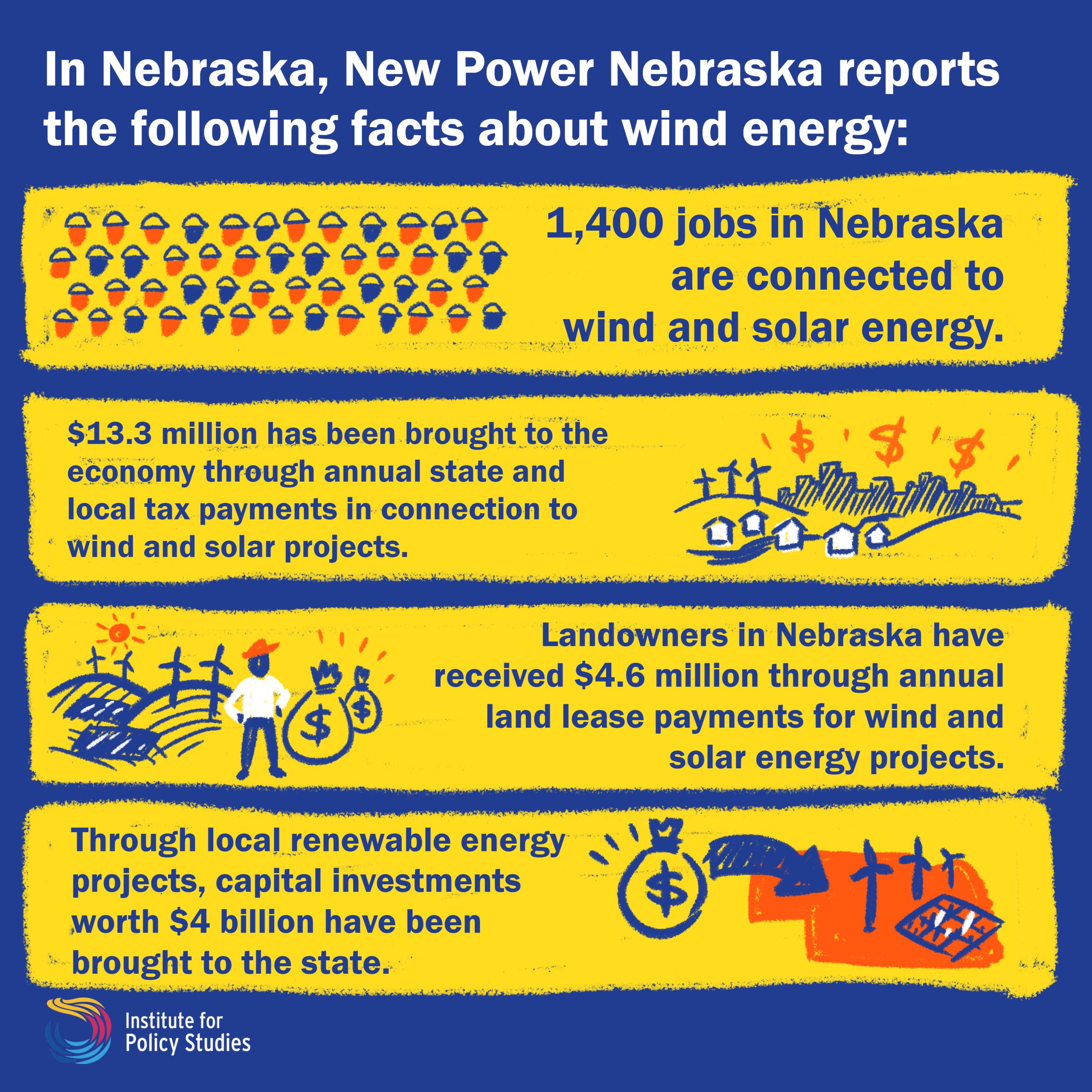Rain and Sunshine and Wind
How an Energy Transition Could Power Nebraska
Basav Sen | Aila Ganić
Introduction
Nebraska has the ability to transition out of the dirty fossil fuel industry and into the future of renewables. The state ranks fourth in the country for wind energy potential, yet as of 2020 produced just 24 percent of its net electricity generation through wind. It has the potential to do much more.
By making a just transition to wind energy, Nebraska can become a leader in renewables and ensure a more sustainable future for Nebraskan communities.
The state’s reliance on coal for energy has threatened Nebraskans for decades. Fossil-fueled climate change has contributed to disastrous floods and droughts in Nebraska. If the state continues to rely on fossil fuels and emit greenhouse gases, research has shown the state will face extreme high temperatures and decreases in soil moisture.
Additionally, the presence of coal plants has led to adverse health impacts in nearby communities, such as high rates of asthma and even death. These coal plants have been situated in communities predominantly inhabited by people of color, including around the North Omaha coal plant.
Wind energy will lead to a healthier future, both environmentally and economically. Wind doesn’t just prevent the pollution that comes with burning fossil fuels — it also prevents the air and water pollution produced when these fuels are mined, drilled, and transported. This means that wind energy development, unlike fossil fuel energy, does not risk exposing groundwater or livestock and communities to toxic pollutants.
The economic benefits of wind energy are also plenty in terms of sustainable employment, wages, land lease payments, and property tax revenues. Consider these national figures:
— In 2019, the coal industry lost nearly 8,000 jobs, while the renewable energy sector added 10,900 jobs.
— The median hourly wage for wind turbine service technicians ($27.03) is much higher than the median for all construction and extraction jobs ($23.37).
— Land lease payments for wind energy development ($706 million nationwide in 2019) also provide a source of income for rural communities.
— Annual property tax payments for wind energy facilities average $7,000 per MW of installed capacity.
So how can Nebraska transition away from the fossil fuel industry while ensuring that the needs and livelihoods of Nebraskans are put first? We recommend three tools: Renewable Portfolio Standards (RPS), net metering, and community-owned energy.
Renewable Portfolio Standards are laws or regulations that specifically direct and incentivize utilities to produce a larger share of renewable energy.
Forty-five percent of the growth of renewable energy between 2000 and 2020 is attributable to RPS policies, providing evidence that they are effective in promoting clean energy. This model for renewable energy growth helps to reduce the cost of renewable energy and helps to ensure that the promised growth of renewable energy actually occurs. Nebraska does not currently have a RPS.
Net metering lowers energy bills by allowing communities to sell energy back to the grid and receive credit for their next bill if they produce more renewable energy than they consume. Net metering incentivizes distributed energy, which comes with the advantages of a reduced bill for consumers, lower fossil fuel usage, and more energy cost stability.
While Nebraska does have a net metering policy, it has a very restrictive cap and is not robust enough to provide the full financial benefit to incentivize growth of distributed energy.
Wind energy generation co-ops give communities autonomy over their energy and remove corporate ownership of generation capacity from the mix. In practice, this takes the form of households forming a cooperative or community non-profit to own and operate a small wind or solar generation facility that sells electricity to the utility. Members of the co-op then receive net metering benefits on their household utility bills, even though the facility is not necessarily on the property of any of the members.
Benefits of this structure include more secure electricity rates, accessibility for low-income households who may not be able to afford the up-front costs of a distributed generation system on their own property, and locating wind energy in the most advantageous spot.
Nebraska could promote more community-owned energy generation by requiring utilities to purchase power from community-owned facilities in their service territory — and requiring them to provide the same net metering benefits to community-owned distributed generation as they provide to distributed generation owned by individual households or businesses.
Make Nebraska’s Public Utilities Work for the Public
Nebraska is in a unique and particularly advantageous position as the only state that is supplied by 100 percent public utilities. All utilities in Nebraska are either governmental entities (such as the Nebraska Public Power District and Omaha Public Power District), or cooperatives owned by the rate paying customers (known as Rural Electric Cooperatives). Their Boards of Directors are either elected by the public or appointed and confirmed by elected officials (as is the case with the Lincoln Electric System). This gives Nebraska residents the ability to hold their utilities accountable to serving the public interest.
This means that public power districts can prioritize Nebraskans’ needs over party politics and set 100 percent clean energy goals across the state while bypassing the state Legislature. Putting the community’s best interests first will enable Nebraskans to have a voice in choosing to transition to wind energy.
This state with tremendous amounts of wind energy potential must take advantage of the opportunity to reduce the health and economic risks that come from relying on coal for energy. Nebraskans deserve a livable future with less water and air pollution, more sustainable jobs, and democratic control over their energy sources.



